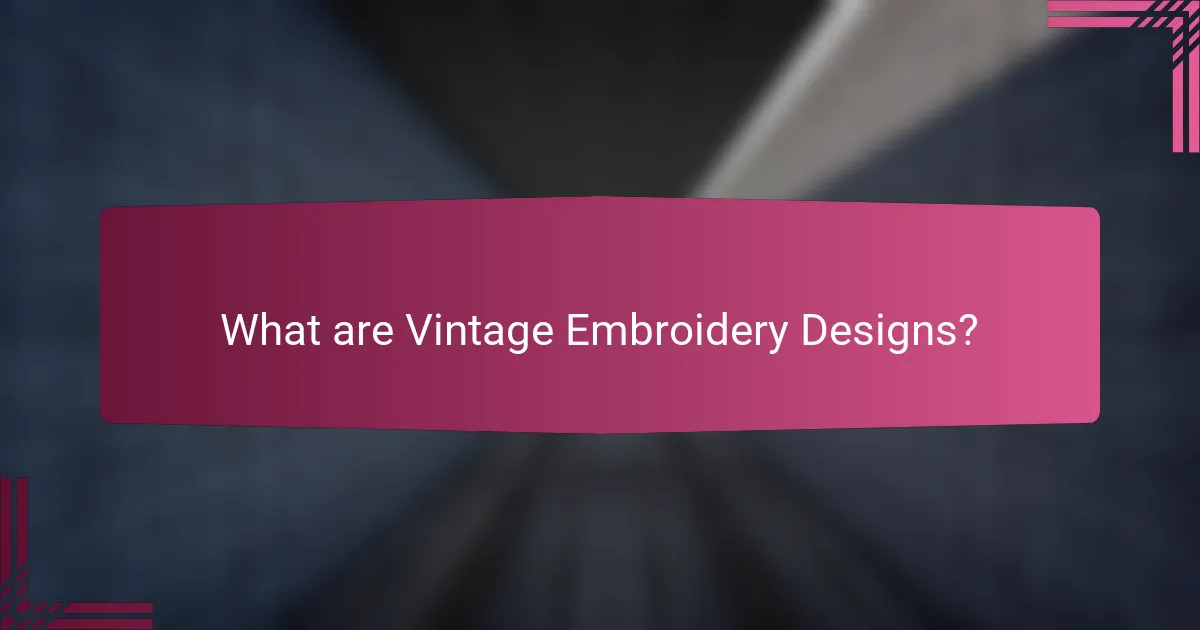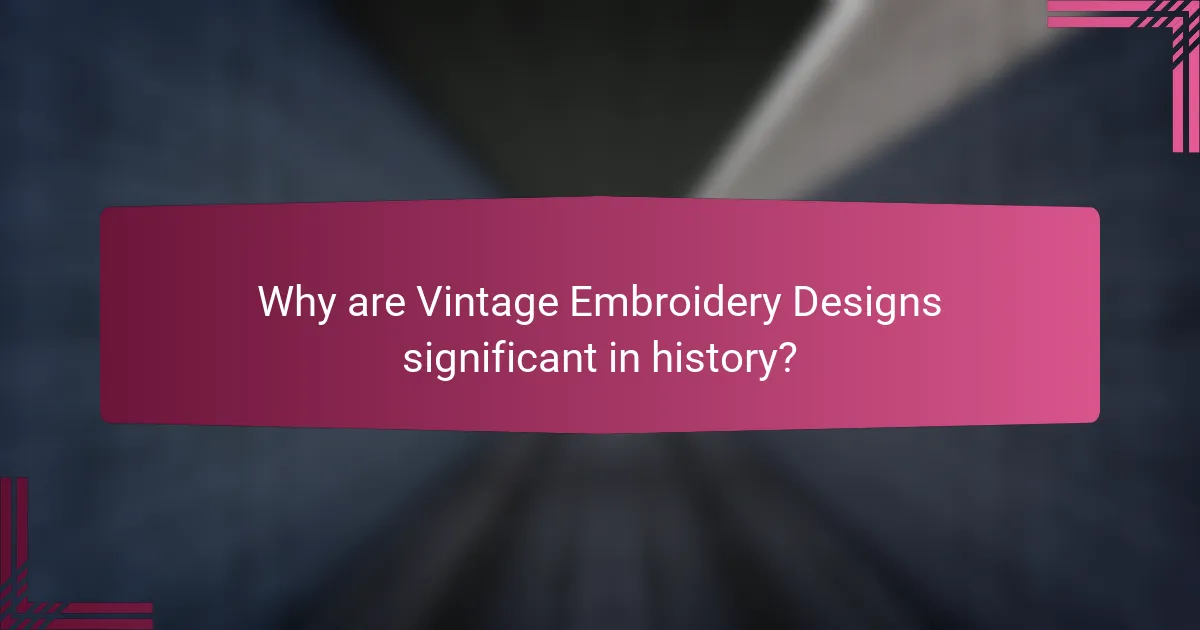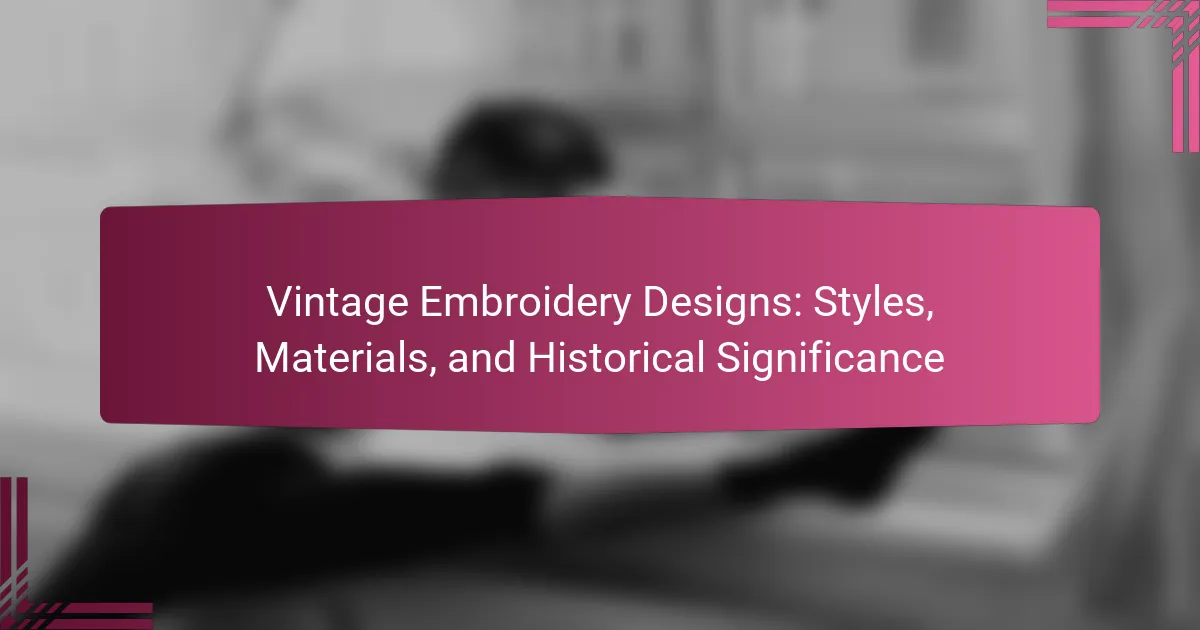
What are Vintage Embroidery Designs?
Vintage embroidery designs are decorative needlework patterns that reflect historical styles and techniques. These designs often feature intricate motifs, floral patterns, and detailed stitching. They typically originate from various cultural backgrounds and time periods, showcasing the artistry of past generations. Vintage embroidery has been preserved in textiles, clothing, and home décor items. The popularity of these designs has increased due to their aesthetic appeal and nostalgic value. Collectors and artisans often seek out vintage embroidery for restoration or inspiration in contemporary craft. Historical examples include Victorian, Art Nouveau, and Colonial American styles. These designs serve as a tangible connection to the craftsmanship of earlier eras.
How did Vintage Embroidery Designs originate?
Vintage embroidery designs originated from traditional hand-stitching techniques used across various cultures. These techniques date back thousands of years, with evidence found in ancient artifacts. Different regions developed unique styles based on local customs and available materials. The rise of the Industrial Revolution in the 18th and 19th centuries popularized machine embroidery. This led to the mass production of embroidered textiles, making designs more accessible. Vintage styles often reflect the aesthetics of their time, incorporating motifs and patterns that were fashionable. Today, vintage embroidery is celebrated for its craftsmanship and historical significance.
What historical events influenced the development of these designs?
The development of vintage embroidery designs was influenced by several historical events. The Industrial Revolution in the 18th and 19th centuries introduced mechanized textile production. This shift allowed for mass production of embroidered fabrics, making them more accessible. The Arts and Crafts Movement in the late 19th century emphasized handmade craftsmanship. This movement led to a revival of traditional embroidery techniques. World War I and II also impacted design trends, as women took on new roles and created practical yet decorative pieces. The cultural exchange during the colonial period introduced diverse motifs and techniques. Each of these events contributed to the evolution of vintage embroidery styles and materials.
What cultural factors contributed to the popularity of Vintage Embroidery Designs?
Cultural factors contributing to the popularity of Vintage Embroidery Designs include nostalgia and a resurgence of artisanal crafts. Nostalgia for past eras drives interest in vintage aesthetics. The handmade movement emphasizes unique, crafted items over mass production. Social media platforms showcase vintage embroidery, increasing visibility and appreciation. Cultural heritage plays a role in preserving traditional techniques. Economic factors also influence popularity, as vintage designs often represent affordable luxury. A growing interest in sustainable fashion promotes the use of vintage materials. These factors collectively enhance the appeal of vintage embroidery in contemporary culture.
What are the main styles of Vintage Embroidery Designs?
The main styles of vintage embroidery designs include Crewel, Blackwork, and Jacobean. Crewel embroidery features wool thread on linen fabric, often showcasing floral and foliage patterns. Blackwork utilizes black thread on white fabric, creating intricate geometric designs. Jacobean embroidery is characterized by its elaborate motifs inspired by nature, often using vibrant colors and diverse stitches. These styles reflect historical techniques and cultural influences from various periods. For example, Crewel dates back to the 17th century in England. Blackwork has roots in medieval Europe, while Jacobean emerged in the early 17th century. Each style has unique attributes that contribute to its historical significance.
What distinguishes each style of Vintage Embroidery?
Each style of Vintage Embroidery is distinguished by its unique techniques, patterns, and historical context. For example, Crewel embroidery features wool threads and intricate floral designs, typical of the Jacobean era. Blackwork is characterized by its monochromatic designs using black thread on white fabric, often depicting geometric patterns. Hardanger embroidery, originating from Norway, utilizes white thread and cutwork techniques, showcasing a lace-like effect. Whitework includes various techniques like broderie anglaise and is marked by its use of white threads on white fabric, creating subtle textures. Each style reflects the cultural influences and materials available during its time, making them distinct in both aesthetics and craftsmanship.
How have these styles evolved over time?
Vintage embroidery designs have evolved significantly over time. Initially, these styles were influenced by cultural and regional traditions. In the Middle Ages, embroidery focused on religious themes and was often used to embellish liturgical garments. As time progressed, the Renaissance period brought intricate patterns and the use of silk threads. The Industrial Revolution introduced mechanization, making embroidery more accessible and diverse. In the 20th century, modernist movements led to abstract designs and innovative techniques. Today, vintage embroidery styles are celebrated for their craftsmanship and are often revived in contemporary fashion. This evolution reflects changing artistic trends and technological advancements throughout history.
What materials are commonly used in Vintage Embroidery Designs?
Common materials used in vintage embroidery designs include cotton, silk, and linen. Cotton is popular for its durability and ease of use. Silk adds a luxurious sheen and is often used for intricate patterns. Linen is favored for its strength and texture, providing a rustic feel. Additionally, wool may be used for warmth and dimension in certain designs. These materials were historically available and contributed to the unique aesthetic of vintage embroidery. Their characteristics influenced the techniques and styles of different eras.
What types of fabrics are preferred for these designs?
Cotton and linen are preferred fabrics for vintage embroidery designs. These fabrics provide a sturdy base for intricate stitching. Cotton is widely used due to its softness and durability. Linen, known for its natural texture, offers a classic look. Silk is another popular choice, adding a luxurious sheen to the designs. Wool is occasionally used for its warmth and texture. Each fabric type enhances the overall aesthetic of vintage embroidery.
How do different threads affect the quality of Vintage Embroidery?
Different threads significantly affect the quality of Vintage Embroidery. The type of thread influences the texture, durability, and overall appearance of the embroidery. Cotton threads are commonly used for their softness and color vibrancy, enhancing visual appeal. Silk threads provide a luxurious sheen but may be less durable than cotton. Synthetic threads can offer strength and fade resistance but might lack the authenticity of natural fibers.
The weight of the thread also impacts the stitch definition and coverage. Thicker threads can create bold designs, while finer threads allow for intricate detailing. Historical practices favored specific threads, affecting the authenticity and value of vintage pieces. For instance, early 20th-century embroidery often utilized hand-dyed threads, contributing to unique color variations. Overall, the choice of thread is crucial in determining the quality and aesthetic of Vintage Embroidery.

Why are Vintage Embroidery Designs significant in history?
Vintage embroidery designs are significant in history because they reflect cultural identities and artistic expressions of their time. These designs often showcase traditional techniques passed down through generations. They provide insight into the social and economic conditions of various eras. For example, certain patterns can indicate regional influences or historical events. Additionally, vintage embroidery serves as a visual record of fashion trends and domestic life. Many pieces are now considered valuable artifacts, illustrating the craftsmanship of past artisans. Their preservation contributes to our understanding of textile history and heritage.
What role did Vintage Embroidery play in different cultures?
Vintage embroidery served as a significant form of artistic expression across various cultures. It reflected social status and identity in many societies. In Europe, intricate designs often indicated wealth and craftsmanship. In Asia, embroidery was used to convey cultural stories and traditions. Many indigenous cultures utilized embroidery to preserve history and heritage. For example, Mexican embroidery showcases vibrant colors and patterns that represent local customs. In Africa, embroidery often symbolizes community and personal narratives. Each culture adapted vintage embroidery to convey unique meanings and aesthetics. This diversity highlights the role of vintage embroidery as a universal language of creativity and cultural identity.
How did Vintage Embroidery reflect societal changes?
Vintage embroidery reflects societal changes through its evolving styles and techniques. Each era’s designs often mirror cultural values and social norms. For example, during the Victorian era, intricate floral patterns symbolized wealth and femininity. In contrast, the 1920s saw simpler, geometric designs reflecting modernism and the changing roles of women. Additionally, post-war periods embraced patriotic themes, showcasing national pride. The materials used also indicate shifts in accessibility and technology. The transition from hand-stitched to machine-made embroidery represents industrial advancements. Overall, vintage embroidery serves as a visual record of historical shifts in society, illustrating the connection between art and cultural identity.
What stories do Vintage Embroidery Designs tell about their time?
Vintage embroidery designs reflect the cultural, social, and economic conditions of their time. Each design often tells stories of the era’s fashion trends and technological advancements. For instance, floral motifs were popular in the Victorian era, symbolizing romance and nature. The use of specific colors can indicate the dyeing techniques available during that period.
Additionally, embroidery patterns can reveal insights into the daily lives of women, who typically created these pieces. Historical records show that certain stitches and techniques were passed down through generations, preserving family traditions. Vintage designs also demonstrate the influence of historical events, such as the Art Deco movement, which embraced geometric patterns.
Moreover, the materials used in these designs, like silk or cotton, can signify economic status. The availability of resources often dictated the complexity and richness of the embroidery. Overall, vintage embroidery designs serve as a tangible connection to the past, illustrating societal values and artistic expressions of their time.
How are Vintage Embroidery Designs preserved today?
Vintage embroidery designs are preserved today through careful conservation techniques. These techniques include proper storage in acid-free materials to prevent deterioration. Additionally, digital archiving is utilized to create high-resolution images of the designs. Museums and collectors often employ climate control to maintain optimal temperature and humidity levels. Restoration experts may also repair damaged pieces using specialized methods. Educational programs and workshops help to pass on traditional skills. Finally, online platforms facilitate the sharing and appreciation of vintage designs.
What techniques are used to maintain the integrity of these designs?
Techniques to maintain the integrity of vintage embroidery designs include careful handling and storage. Proper archival methods prevent damage from light and moisture. Using acid-free materials for display preserves the fabric’s quality. Regular cleaning with gentle methods removes dirt without harming the threads. Conservation professionals often recommend avoiding direct sunlight to prevent fading. Additionally, employing low-humidity environments helps to prevent mold growth. These practices ensure that the designs remain intact for future generations.
How can collectors ensure the longevity of Vintage Embroidery pieces?
Collectors can ensure the longevity of Vintage Embroidery pieces by following proper care and storage practices. Keeping these pieces away from direct sunlight prevents fading and deterioration. Maintaining a stable, cool temperature and low humidity protects the fabric from mold and mildew. Using acid-free materials for storage, such as tissue paper and boxes, minimizes chemical exposure that can damage the embroidery. Regularly inspecting the pieces for signs of wear allows for timely repairs, preserving their condition. Additionally, avoiding heavy handling reduces the risk of fraying or tearing. These practices are supported by conservation guidelines from textile preservation experts.

What are the practical applications of Vintage Embroidery Designs today?
Vintage embroidery designs are used today in various practical applications. They enhance home decor by adding unique, artistic elements to textiles. Many people incorporate these designs into fashion items, such as clothing and accessories. Vintage embroidery is also popular in crafting, where enthusiasts create personalized gifts or decor. The designs can be applied to upholstery, giving furniture a distinctive character. Additionally, they are often featured in quilting projects, enriching the overall aesthetic. Vintage embroidery is utilized in educational settings to teach traditional needlework techniques. Lastly, these designs are frequently used in branding, helping businesses convey a sense of heritage and craftsmanship.
How can Vintage Embroidery be incorporated into modern fashion?
Vintage embroidery can be incorporated into modern fashion through various techniques. Designers often use vintage embroidery as embellishment on contemporary garments. This can include adding embroidered patches to jackets or shirts. Another approach is to create new patterns inspired by vintage styles. These patterns can be printed on modern fabrics. Vintage embroidery can also be featured in accessories like bags and scarves. Additionally, upcycling vintage embroidered pieces into new outfits is a popular trend. This method promotes sustainability while honoring traditional craftsmanship. Incorporating vintage embroidery connects modern fashion with historical artistry.
What are some popular trends in using Vintage Embroidery in contemporary designs?
Contemporary designs increasingly incorporate vintage embroidery trends. One popular trend is the use of floral motifs inspired by historical patterns. Designers often blend these motifs with modern fabrics and silhouettes. Another trend is the revival of traditional stitching techniques such as cross-stitch and satin stitch. This adds authenticity and craftsmanship to contemporary pieces. Additionally, upcycling is a significant trend, where vintage embroidered textiles are repurposed into new garments. This practice promotes sustainability while showcasing unique vintage designs. The combination of old and new creates a distinctive aesthetic that appeals to modern consumers.
What tips can enhance your understanding and appreciation of Vintage Embroidery Designs?
Study the history of vintage embroidery designs. Understanding their origins adds context to their significance. Explore different styles, such as crewel, cross-stitch, and satin stitch. Each style has unique techniques and cultural backgrounds. Examine various materials used, including silk, cotton, and linen. These materials influence the texture and durability of designs. Attend workshops or classes focused on vintage embroidery. Hands-on experience enhances appreciation and skill. Join online forums or local groups to connect with enthusiasts. Sharing insights can deepen understanding. Visit museums or exhibitions showcasing vintage embroidery. Observing pieces in person reveals intricate details and craftsmanship.
How can you identify authentic Vintage Embroidery pieces?
To identify authentic Vintage Embroidery pieces, examine the stitching techniques used. Authentic vintage pieces often feature hand-stitched techniques, which differ from machine-made embroidery. Check for irregularities in stitching, as they indicate handmade craftsmanship. Look for vintage materials such as cotton or silk, which are commonly used in older pieces. Authentic items may also display natural wear and fading, reflecting their age. Research specific patterns or motifs, as these can help date the piece. Additionally, labels or tags can provide information about the maker or origin. Always compare with verified examples to confirm authenticity.
What resources are available for learning more about Vintage Embroidery techniques?
Books on vintage embroidery techniques include “The Embroidery Book” by Anne Butler. Online platforms like Craftsy and Skillshare offer courses on vintage styles. YouTube channels dedicated to embroidery provide tutorials and demonstrations. Museums often have workshops focused on historical embroidery techniques. Local sewing guilds may host classes on vintage embroidery. Websites like Pinterest and Instagram showcase vintage embroidery projects for inspiration.
Vintage embroidery designs are decorative needlework patterns that showcase historical styles and techniques, often characterized by intricate motifs and cultural influences. This article explores the origins, evolution, and significance of these designs, highlighting key styles such as Crewel, Blackwork, and Jacobean, as well as the materials commonly used, including cotton, silk, and linen. Additionally, it examines the impact of historical events and cultural factors on the popularity of vintage embroidery, its practical applications in modern fashion and home decor, and preservation techniques to maintain the integrity of these artistic expressions.
